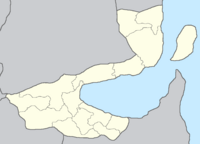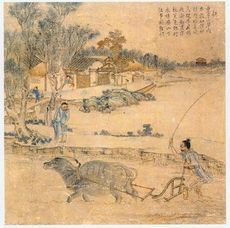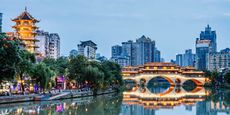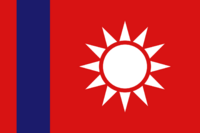Wodai
Wodai 沃埭市 Wòdài shì | |
|---|---|
City | |
Clockwise from top: Wodai Financial Area, Wodai International Business Park, Temple of Heaven | |
Map of Monsilva with Wodai highlighted | |
| Country | |
| State | |
| Settled | 10th century BCE |
| Declared city | 7 November 1422 |
| Wuzhong state est. | 1 July 1984 |
| Government | |
| • Body | Wodai City Council |
| • Mayor | Wei Lanfen (FDP) |
| Population (July 2022) | |
| • Total | 2,245,521 |
| Time zone | AMT+12 (Monsilvan Western Time, MWT) |
| ISO 3166 code | MS-WUZ-W |
| Major airports | Wodai City Airport (WCA) |
| Transit System(s) | MRA Western Railways Administration Wodai Metro |
| Police[1] | Wodai Metropolitan Police |
| Ambulance[2] | Wuzhong State Ambulance |
| Fire[3] | Wuzhong Fire Service |
Wodai (Monsilvan: 沃埭市; pinyin: Wòdài shì), is a city in Monsilva and the capital of the state of Wuzhong. It is located in the center of the state, which itself is located in western Monsilva, away from the coast and towards the border with Baltanla. As the capital of Wuzhong, it is the seat of the Wuzhong State Government, and is home to the Wuzhong State Office. The city has an estimated population of 2,245,521 (July 2022). Wodai is Monsilva's 8th most-populous city, falling just behind Zhangye but well ahead of Chishang. The city holds 61% of the state of Wuzhong's population, with the other 39% living in the state's 4 other cities or in towns scattered across the state's rural area.
Wodai is located on the Cha River which starts in the mountains of western Wuzhong and forks into multiple tributaries around where the city is located and later converges near the town of Nanjue, just outside of Wodai. This forked river has made the land around it very arable, which has allowed it to remain inhabited for many thousands of years. However, in early history, its seclusion away from most of Monsilva kept its population rather low in comparison with the rest of what is Monsilva today. In 50 CE, the Han dyansty was founded in Wodai and consisted of a large portion of western Monsilva, and later included half of the Xiaoguan stretch. Wodai always centred its business around markets and commercial business, being a frequently visited stop for travellers from west Ostlandet going north. Nowadays, Wodai's commercial history is still present, with companies such as LM Mart and Leguanda Company which are both large commercial companies.
Wodai is also a large tourist destination. Well known landmarks, both natural and man-made, in the city include: the Temple of Heaven, Wodai International Business Park, Wenshu Monastery, Qingyang Taoist Temple, Lijin Street Market and Shun'an Bridge. Education in Wodai is good, with many educational institutions in the city. The University of Wodai is a highly-regarded economics, business and politics university, renowned for its incredibly high entry requirements.
The city is well connected to the rest of the country. Railways, highways, airports and bus lines connect Wodai to the rest of Monsilva and internationally. The city is served by Wodai City Airport which is located in the north-east of the city. High-speed rail services run out of Wodai Station towards Amking, passing Sanzhong and connecting to other rail services to the north of Monsilva via Sigong. Other rail services run by the Monsilvan Railway Administration run from Wodai to cities such as Lancheng, Waiping, Zhangye and Taimali. More frequently stopping services around the states of Wuzhong, Weishi and Xishanjia are operated by the Western Railways Administration. Serving just the city of Wodai is the Wodai Metro.
Contents
Toponymy
The name, Wodai comes directly from the HY Pinyin of the Monsilvan "沃埭", (Wòdài). The name "沃埭" comes from the Monsilvan words 沃 (wò), meaning "fertile", and the word 埭 (dài), meaning "embankment" or "dike". The name has been discovered to be a portmanteau of the phrases "沃地" (Wò de), meaning "fertile land", and "河埭" (Hé dài), meaning "river dike". The phrases likely refer to the land on which Wodai sits, which is made up of many fertile and arable islets which lie on the Cha River.
History
Prehistory and early dynasties
Wodai has been inhabited for many thousands of years, however its population remained at a stagnant low number for many of those years. Wodai as a town did not develop until the late 2nd century BCE, but the lands on which Wodai are today were inhabited by many people, but these people were spread out over farms and villages rather than in one large town or city.
The population of the Wodai region only beginning to grow significantly by the coming of the 1st century CE when the Han dyansty was founded with Wodai as its principal city and capital. The Han dynasty quickly grew into one of the strongest of the Monsilvan dynasties, making strong allies with the rich Zhong dynasty located in what is northern Monsilva today, and conquered the Tang dynasty in around 650 CE, which gave sea access to the dynasty for the first time.
Zhou dynasty and the Empire of Baltanla
In 1201 CE, the dynasties of Monsilva united into the Zhou dynasty. Although Wodai's political significance fell, its cultural and industrial significance grew. As the largest settlement in western Monsilva by far, Wodai became an important outpost for inland travellers who were travelling between the south and north of the continent. Thanks to this, Wodai began developing its reputation as a hub for commercial and international business in Monsilva. Culturally, Wodai was also home to many temples dedicated to Buddhism, Taoism and Confucianism which many religious travellers would visit from all across Terraconserva. The city was also home to many monks who would teach the ways of Shaolin Kung Fu and other martial arts, which have remained an important part of the city's culture today.
During the fall of the Zhou dynasty in the late 15th century, Wodai's business continued but did not continue without trouble. The strain on resources in the dynasty seriously affected the operations in the city, with many businesses relocating or receiving funding from the nearby Empire of Baltanla which already had interests in annexing the dynasty. The Empire was planning to use its control over the city as a bargain for the Zhou dynasty, however it became unnecessary as the Zhou dynasty voluntarily ceded itself to the empire in 1568.
Under the Empire of Baltanla, Wodai lay right in-between Monsilva and the region of Baltanla, which made it the perfect place for travellers, merchants and other people to purchase and sell goods or stay overnight before remaining to continuing elsewhere. This grew the city's economy and has largely contributed to the city's diverse business culture today.
Kingdom of Great Shan and the Civil War
After Monsilva left the Empire of Baltanla in 1730, Wodai had become one of Monsilva's largest cities. During the Kingdom of Great Shan which formed out of the now independent Monsilva, Wodai was a very important city, as it was the largest in the west of the country and allowed the government to administer the remote west from the city. Although its economy grew, the population of Wodai began to stagnate in the early 19th century.
When the Monsilvan Civil War struck out in 1824, Wodai did not suffer much physically, however as the years went on, the city began suffering through lack of resources as internal trading began ceasing. The city suffered through bad famines during the later years of the war with many people dying and businesses falling under. It took around 15 years for the city to fully recover after the war ended in 1830.
Kingdom of Monsilva and the Republic
Now that the Kingdom of Monsilva had been established and the war was over, the people began recieving food once more and businesses began recovering. However it took many years before Wodai returned to its former bustling state. Fortunately, thanks to the war not reaching Wodai physically, it had kept many of its old landmarks which many cities were not as lucky to keep. This gave Wodai a somewhat unique position of being fully intact but with a distinct lack of people.
During the 1910s and 1920s, large amounts of immigration from neighbouring countries into Monsilva began a population boom in Wodai, where its population doubled in less than 5 years. This sudden boost to Wodai's population also helped put its economy back on track and lead to the founding of many new large businesses, some of which remain as big companies today. Wodai began growing so much that it was considered one of the top 3 largest cities by area thanks to the many tributaries causing suburbs to be spread out much further than usual.
During martial law in Monsilva, Wodai's famously bustling nature quickly became very static as many businesses were acquired by the government forcing people into government-designated housing, as well as the restriction of street markets and strict curfews. This killed Wodai's nightlife and lead to its nickname of the quiet city, where despite busy streets, they were almost silent as people were told they could not chat on streets. Wodai suffered under many of the regime's rules which highly restricted its culture. These restrictions were likely why the protests in Wodai during the late 1970s and during the 1978 Mass Protests were the most violent, with a large portion of total injuries and deaths resulting from these protests taking place in the city.
Government
Local government
Wodai has its own city council, the head of which is the Mayor of Wodai. The council serves as a de-facto upper house to the 5 county councils within the city council's jurisdiction. The council is currently lead by the Freedom and Democracy Party.
State government
Wodai, as the capital of Wuzhong, is home to the Wuzhong State Government in the State Office. The Wuzhong State Parliament, also in the State Office, is a 80-seat unicameral legislature which serves the entire state of Wuzhong, including the city. The seats correspond to each municipality of the state, many of which are Wodai's urban municipalities.
Geography
Wodai is located upon the Cha River which forks into many tributaries forming the many islets on which the city's center lies. Thanks to this, the city has many bridges, including the famous Shun'an Bridge in the city's center. The city was developed upon large amounts of hilly arable land once dominated by rice fields, many of which have now been replaced with the sprawling suburbs of the city. Wodai is one of Monsilva's hilliest cities, with some points being over 150 meters above sea-level.
In terms of climate, the city is very warm during the summer, but thanks to its somewhat high altitude, unlike much of the country, its winters are somewhat cool, reaching temperatures as low as 8 degrees celcius at the peak of winter. Its hilly nature has also prevented its many rivers from causing major flooding damage during rainy seasons.
Cityscape
Demography
As of 2022, there are just over 2.2 million people living within Wodai's metropolitan area, making it Monsilva's seventh-largest city by population, falling just behind Zhangye but ahead of Chishang. Wodai has a very dense city center, with some of the country's highest skyscrapers being located in the city. Meanwhile the city's suburbs are highly spread out due to the hilly nature of the city's outskirts. As with most urban areas in Monsilva, Wodai has a diverse population. Although the majority of residents are Monsilvan, there are still noticeable diasporas of other nationalities, such as Baltanese and Akvarelians. Wodai has the highest Baltanese population of any city in Monsilva, likely due to its proximity to the country.
Most residents of Wodai adhere to Buddhism. However, there is also many followers of the nationwide Monsilvan folk religion as well as a rapidly growing population of people unaffiliated with a religion and a small number of other religions such as Christianity and Islam.
Transport
Wodai, as an important city in Monsilva, is well connected to the rest of the nation. The city is served internally by the Wodai Metro, but is also served nationally by the Monsilvan Railways Administration and the Western Railways Administration. The MRA runs commuter and high-speed services across Wuzhong as well as to cities such as Sanzhong, Taimali, Waiping, Amking and Zhangye. While the WRA runs services in the west of the country, with more frequent stops at smaller towns and villages. The city is also served by Wodai City Airport, Monsilva's 6th busiest airport.
Education
Wodai has many education institutions across the city, from elementary schools to universities. The city is home to the University of Wodai, a highly regarded business, economics and politics university which is renowned in Monsilva for its difficult entry requirements. Many of Monsilva's most important politicians, including ones who represent outside of Wuzhong, have studied at the university. Unlike most states where it is up to 16, education in the state of Wuzhong is mandatory up to the age of 18.
Outside of universities, the city is also home to many business apprenticeships and industrial experience courses, where many companies hire students straight out of high-school and educate them on a business's operations from within the company while paying them, in exchange for company dedication. Many people have criticized this practise as restrictive on students' futures, however the practise remains popular in the city nonetheless.
Culture
Sport
Football and martial arts are the most popular sports in Wodai. Martial arts have a deep history in the city, especially Shaolin Kung Fu which is practiced in many schools and is taught by many monks who reside in and near to the city. However, football, as the most popular sport in the country, still has a large influence on sporting culture in the city. Wodai City F.C., the city's most popular professional football team is currently in the Monsilvan Super League.
Sports in general are a large part of culture in Wodai, with many of the city's largest companies claiming that they are finding it almost necessary to open gyms and other sport facilities within their businesses to accommodate the sporting needs of its employees.
Tourism
Wodai is home to many man-made and natural landmarks which are popular among residents, domestic and international tourists. Examples of these attractions include:
- The Temple of Heaven, a complex of religious buildings and is very popular destination for many followers of Confucianism.
- Lijin Street Market, also a popular destination during the night time, when it is at its busiest and people can purchase all sorts of different items and partake in many different activities.
- Wodai International Business Park, famous for its extravagant high-tech buildings and its many businesses from all across Terraconserva.
- Shun'an Bridge, although one of many bridges in the city, is one of the city's most popular tourist attractions due to its long history and nature as a covered bridge containing shops and a popular restaurant.
- Wodai Observer Tower.
- Wenshu Monastery.
- Qinyang Taoist Temple.
See also
| Rank | State | Pop. | Rank | State | Pop. | ||||
|---|---|---|---|---|---|---|---|---|---|
 Amking  Luhai |
1 | Amking | Amking | 10,855,226 | 11 | Sanzhong | Weishi | 1,116,871 |  San Kong  Menchi |
| 2 | Luhai | Luhai | 5,050,800 | 12 | Haimao | Leibo | 1,042,225 | ||
| 3 | San Kong | Shaoyu | 4,066,512 | 13 | Yinjiang | Shaoyu | 984,717 | ||
| 4 | Menchi | Meixian | 3,973,229 | 14 | Huiyong | Shaoyu | 826,314 | ||
| 5 | Maojie | Maguan | 3,461,317 | 15 | Tsingyi | Luhai | 800,179 | ||
| 6 | Shangrao | Donguan | 2,953,057 | 16 | Baoan | Zaixian | 795,974 | ||
| 7 | Zhangye | Xiaogu | 2,585,883 | 17 | Taimali | Xishanjia | 776,469 | ||
| 8 | Wodai | Wuzhong | 2,245,521 | 18 | Dali | Wuzhong | 596,911 | ||
| 9 | Chishang | Huachang | 1,674,966 | 19 | Menggu | Bazhong | 584,320 | ||
| 10 | Waiping | Bazhong | 1,445,989 | 20 | Taoyuan | Meixian | 558,627 | ||









